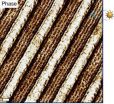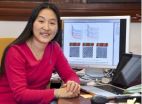(Press-News.org) The days of self-assembling nanoparticles taking hours to form a film over a microscopic-sized wafer are over. Researchers with the U.S. Department of Energy (DOE)'s Lawrence Berkeley National Laboratory (Berkeley Lab) have devised a technique whereby self-assembling nanoparticle arrays can form a highly ordered thin film over macroscopic distances in one minute.
Ting Xu, a polymer scientist with Berkeley Lab's Materials Sciences Division, led a study in which supramolecules based on block copolymers were combined with gold nanoparticles to create nanocomposites that under solvent annealing quickly self-assembled into hierarchically-structured thin films spanning an area of several square centimeters. The technique is compatible with current nanomanufacturing processes and has the potential to generate new families of optical coatings for applications in a wide number of areas including solar energy, nanoelectronics and computer memory storage. This technique could even open new avenues to the fabrication of metamaterials, artificial nanoconstructs that possess remarkable optical properties.
"Our technique can rapidly generate amazing nanoparticle assemblies over areas as large as a silicon wafer," says Xu, who also holds a joint appointment with the University of California (UC) Berkeley's Departments of Materials Sciences and Engineering, and Chemistry. "You can think of it as pancake batter that you can spread over a griddle, wait one minute and you have a pancake ready to eat."
Xu is the corresponding author of a paper describing this research in Nature Communications titled "Rapid fabrication of hierarchically structured supramolecular nanocomposite thin films in one minute." Co-authors are Joseph Kao, Kari Thorkelsson, Peter Bai, Zhen Zhang and Cheng Sun.
Nanoparticles function as artificial atoms with unique optical, electrical and mechanical properties. If nanoparticles can be induced to self-assemble into complex structures and hierarchical patterns, similar to what nature does with proteins, it would enable mass-production of devices a thousand times smaller those used in today's microtechnology.
Xu and her research group have been steadily advancing towards this ultimate goal. Most recently their focus has been on the use of block copolymer-based supramolecular solutions to direct the self-assembly of nanoparticle arrays. A supramolecule is a group of molecules that act as a single molecule able to perform a specific set of functions. Block copolymers are long sequences or "blocks" of one type of monomer bound to blocks of another type of monomer that have an innate ability to self-assemble into well-defined arrays of nano-sized structures over macroscopic distances.
"Block copolymer-based supramolecules self-assemble and form a wide range of morphologies that feature microdomains typically a few to tens of nanometers in size," Xu says. "As their size is comparable to that of nanoparticles, the microdomains of supramolecules provide an ideal structural framework for the self-assembly of nanoparticle arrays."
In the supramolecular technique devised by Xu and her colleagues, arrays of gold nanoparticles were incorporated into solutions of supramolecules to form films that were about 200 nanometers thick. Through solvent annealing, using chloroform as the solvent, the nanoparticle arrays organized into three-dimensional cylindrical microdomains that were packed into distorted hexagonal lattices in parallel orientation with the surface. This display of hierarchical structural control in nanoparticle self-assembly was impressive but was only half the game.
"To be compatible with nanomanufacturing processes, the self-assembly fabrication process must also be completed within a few minutes to minimize any degradation of nanoparticle properties caused by exposure to the processing environment," Xu says.
She and her group systematically analyzed the thermodynamics and kinetics of self-assembly in their supramolecular nanocomposite thin films upon exposure to solvent vapor. They found that by optimizing a single parameter, the amount of solvent, assembly kinetics could be precisely tailored to produce hierarchically structured thin films in a single minute.
"By constructing our block copolymer-based supramolecules from small molecules non-covalently attached to polymer side chains, we changed the energy landscape so that solvent content became the most important factor," Xu says. "This enabled us to achieve fast-ordering of the nanoparticle arrays with the addition of only a very small amount of solvent, about 30-percent of the fraction of a 200 nanometer thick film."
The optical properties of nanocomposite thin films depend on the properties of individual nanoparticles and on well-defined inter-particle distances along different directions. Given that the dimensions of the gold nanoparticle arrays are at least one order of magnitude smaller than the wavelengths of visible light, the supramolecular technique of Xu and her colleagues has strong potential to be used for making metamaterials. These artificial materials have garnered a lot of attention in recent years because their electromagnetic properties are unattainable in natural materials. For example, a metamaterial can have a negative index of refraction, the ability to bend light backwards, unlike all materials found in nature, which bend light forward.
"Our gold nanocomposite thin films exhibit strong wavelength- dependent optical anisotropy that can be tailored simply by varying the solvent treatment," Xu says. "This presents a viable alternative to lithography for making metamaterials."
While Xu and her colleagues used gold nanoparticles in their films, the supramolecular approach is compatible with nanoparticles of other chemical compositions as well.
"We should be able to create a library of nanoparticle assemblies engineered for light manipulation and other properties," Xu says, "using a technique that is compatible with today's most widely used nanomanufacturing processes, including blade coating, ink-jet printing and dynamic zone annealing."
INFORMATION:
This research was funded by the DOE Office of Science and made use of the Advanced Photon Source at Argonne National Laboratory, a DOE Office of Science user facility.
Lawrence Berkeley National Laboratory addresses the world's most urgent scientific challenges by advancing sustainable energy, protecting human health, creating new materials, and revealing the origin and fate of the universe. Founded in 1931, Berkeley Lab's scientific expertise has been recognized with 13 Nobel prizes. The University of California manages Berkeley Lab for the U.S. Department of Energy's Office of Science. For more, visit http://www.lbl.gov.
The DOE Office of Science is the single largest supporter of basic research in the physical sciences in the United States and is working to address some of the most pressing challenges of our time. For more information, please visit science.energy.gov.
Berkeley Lab researchers create nanoparticle thin films that self-assemble in 1 minute
2014-06-09
ELSE PRESS RELEASES FROM THIS DATE:
'Hello, world!' NASA beams video from space station via laser
2014-06-09
"Hello, World!" came the message from the International Space Station as NASA successfully beamed high-definition video via laser from space to ground on Thursday, June 5. The 175-megabit video transmission was the first of its kind for the Optical Payload for Lasercomm Science (OPALS) with the goal of improving the way we receive data from orbit and beyond. In fact, this emerging technology of optical communications--or lasercomm--is likened to an upgrade from dial-up to DSL.
"It's incredible to see this magnificent beam of light arriving from our tiny payload on the ...
African-American women more likely to be diagnosed with higher risk breast cancer
2014-06-09
Washington, D.C., June 9, 2014 - A research study led by cancer specialists at MedStar Washington Hospital Center found that African-American women frequently present with biologically less favorable subtypes of breast cancer.
Researchers at the Hospital Center's Washington Cancer Institute analyzed the biology of breast cancer in 100 African-American women, using a method of genomic profiling. These genomic tests look at the expression of genes associated with the risk of recurrence in the population and further characterizes the biology of the tumor. The 70-gene MammaPrint ...
Affordable housing linked to children's test scores
2014-06-09
It's long been accepted – with little science to back it up – that people should spend roughly a third of their income on housing. As it turns out, that may be about how much a low-income family should spend to optimize children's brainpower.
Johns Hopkins University researchers have explored the effects of affordable housing on the cognitive development, physical health, and emotional wellbeing of children living in poverty. How much a family spends on housing has no impact on a child's physical or social health, they found, but when it came to cognitive ability, it ...
New study finds text messaging program benefits pregnant women
2014-06-09
WASHINGTON, DC (June 9, 2014) – The leading mobile health service in the nation, Text4baby, was found to significantly benefit pregnant women, according to a new study led by Milken Institute School of Public Health (Milken Institute SPH) at the George Washington University and the Madigan Army Medical Center. The pilot study examined several things including the short-term effects of Text4baby exposure four weeks post enrollment on attitudes, beliefs and behaviors targeted by the text messages.
"This study provides the strongest evidence to date that Text4baby reduces ...
Combined MMRV vaccine shows slight rise in adverse events
2014-06-09
The combined measles–mumps–rubella–varicella (MMRV) vaccine shows a slightly increased risk of febrile seizures in children, compared with the previously separate vaccines for MMR and varicella (chickenpox) (MMR+V), according to an article in CMAJ (Canadian Medical Association Journal).
The MMRV vaccine was developed for young children to reduce the number of needles they receive. However, the combined vaccine has been associated with slightly higher rates of febrile seizures.
Febrile seizures can accompany high fever in young children; although distressing, they are ...
Stem cells are a soft touch for nano-engineered biomaterials
2014-06-09
Scientists from Queen Mary University of London have shown that stem cell behaviour can be modified by manipulating the nanoscale properties of the material they are grown on - improving the potential of regenerative medicine and tissue engineering as a result.
Stem cells are special because they are essential to the normal function of our organs and tissues. Previous research shows stem cells grown on hard substrates go on to multiply but do not differentiate: a process by which the cells specialise to perform specific functions in the body. In contrast, stem cells ...
PET/MR is superior for verifying coronary arterial disease
2014-06-09
St. Louis, Mo. (June 9, 2014) – Ischemic heart disease, a narrowing of the arteries supplying blood to the heart, is a leading cause of death throughout the world. A hybrid molecular imaging technique called positron emission tomography and magnetic resonance (PET/MR) imaging, which tells doctors vital information about cardiac and arterial function, has been found to be an effective molecular imaging tool for detecting coronary artery disease (CAD), say researchers at the Society of Nuclear Medicine and Molecular Imaging's 2014 Annual Meeting.
Often patients suspected ...
Stem cell-stimulating therapy saves heart attack patients
2014-06-09
St. Louis, Mo. (June 9, 2014) – Researchers at the Society of Nuclear Medicine and Molecular Imaging's 2014 Annual Meeting revealed how a protein encourages the production of stem cells that regenerate damaged tissues of the heart following an acute attack (myocardial infarction). They further assert that it has a better chance of working if provided early in treatment. This was confirmed by molecular imaging, which captured patients' improved heart health after therapy.
If given after a heart attack, granulocyte colony-stimulating factor (G-CSF) mobilizes bone marrow ...
SPECT/CT reveals best treatment for low back pain
2014-06-09
St. Louis, Mo. (June 9, 2014) – Low back pain is not only excruciating but also debilitating for countless sufferers. Unfortunately, not everyone responds to treatment. A molecular imaging scan in addition to a conventional bone scan can provide the necessary information about the physiological health of the spine to select the most appropriate pain-killing treatment protocol, say researchers at the Society of Nuclear Medicine and Molecular Imaging's 2014 Annual Meeting.
Conventional imaging methods including X-ray, computed tomography and even magnetic resonance imaging ...
Chemo-radionuclide therapy halts neuroendocrine cancer
2014-06-09
St. Louis, Mo. (June 9, 2014) – Advanced cancer of the neuroendocrine system can lead to dismal prognoses, but a novel therapy is packing a punch by uniting powerful radionuclide treatment and chemotherapy drugs, revealed researchers at the Society of Nuclear Medicine and Molecular Imaging's 2014 Annual Meeting.
The research findings show that the experimental therapy led to stabilization or regression of patients' cancer in about 70 percent of cases a year after completion of the treatment, now called peptide receptor chemo-radionuclide therapy (PRCRT). The therapy is ...




